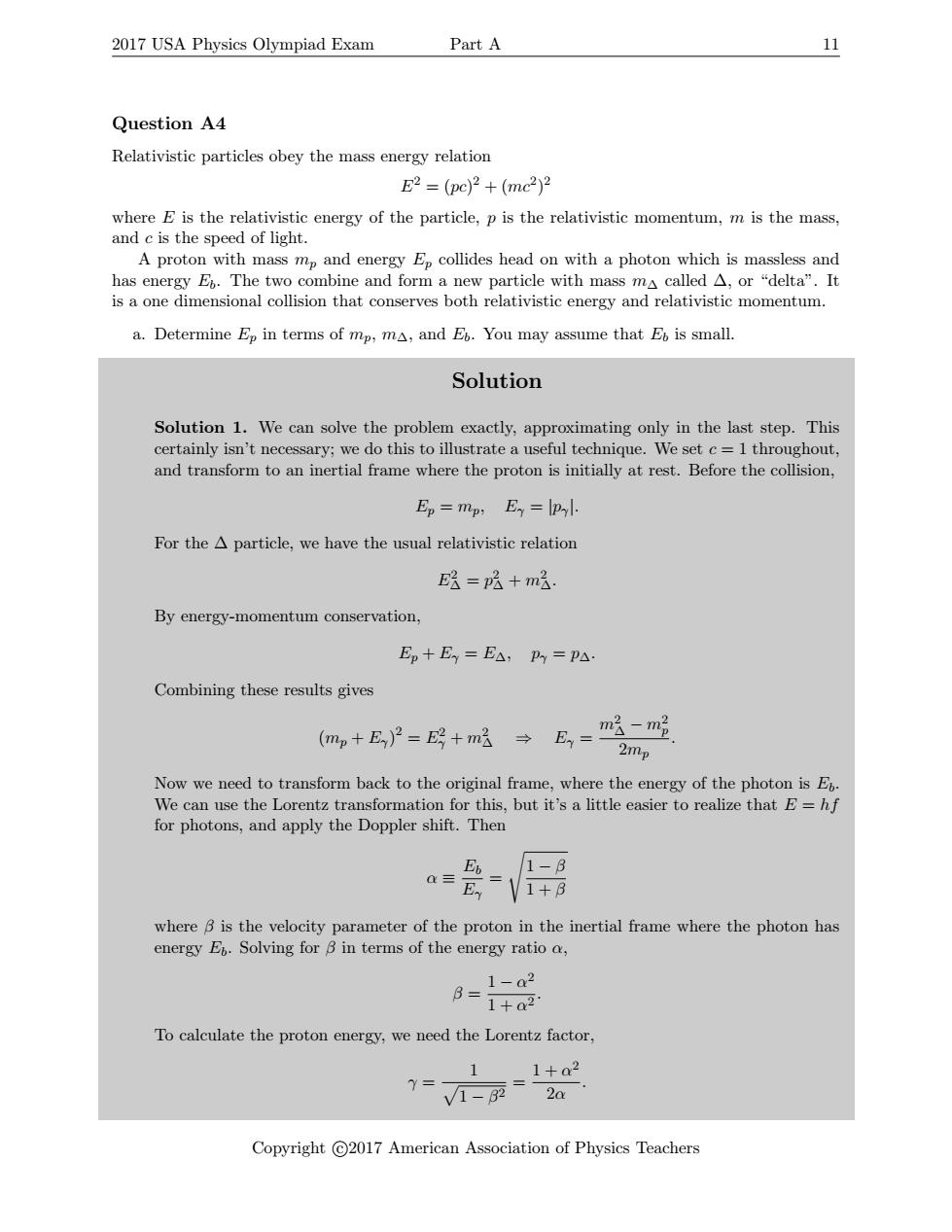正在加载图片...

2017 USA Physics Olympiad Exam Part A 11 Question A4 Relativistic particles obey the mass energy relation E2=(pc)2+(mc2)2 where E is the relativistic energy of the particle,p is the relativistic momentum,m is the mass, and c is the speed of light. A proton with mass mp and energy Ep collides head on with a photon which is massless and has energy E.The two combine and form a new particle with mass mA called△,or“delta'”.It is a one dimensional collision that conserves both relativistic energy and relativistic momentum. a.Determine Ep in terms of mp,mA,and Eb.You may assume that E is small. Solution Solution 1.We can solve the problem exactly,approximating only in the last step.This certainly isn't necessary;we do this to illustrate a useful technique.We set c=1 throughout, and transform to an inertial frame where the proton is initially at rest.Before the collision, Ep mp:E=lpyl. For the A particle,we have the usual relativistic relation E脱=2+m By energy-momentum conservation, Ep十Ey=EA,P=PA Combining these results gives (mp+E)2=E+m2→E= ma-mp 2mp Now we need to transform back to the original frame,where the energy of the photon is E. We can use the Lorentz transformation for this,but it's a little easier to realize that E=hf for photons,and apply the Doppler shift.Then E 1-3 三 1+3 where B is the velocity parameter of the proton in the inertial frame where the photon has energy E.Solving for B in terms of the energy ratio a, 21-a2 B=1+a21 To calculate the proton energy,we need the Lorentz factor, 1 1+a2 Y= V1-2 2a Copyright C2017 American Association of Physics Teachers2017 USA Physics Olympiad Exam Part A 11 Question A4 Relativistic particles obey the mass energy relation E 2 = (pc) 2 + (mc2 ) 2 where E is the relativistic energy of the particle, p is the relativistic momentum, m is the mass, and c is the speed of light. A proton with mass mp and energy Ep collides head on with a photon which is massless and has energy Eb. The two combine and form a new particle with mass m∆ called ∆, or “delta”. It is a one dimensional collision that conserves both relativistic energy and relativistic momentum. a. Determine Ep in terms of mp, m∆, and Eb. You may assume that Eb is small. Solution Solution 1. We can solve the problem exactly, approximating only in the last step. This certainly isn’t necessary; we do this to illustrate a useful technique. We set c = 1 throughout, and transform to an inertial frame where the proton is initially at rest. Before the collision, Ep = mp, Eγ = |pγ|. For the ∆ particle, we have the usual relativistic relation E 2 ∆ = p 2 ∆ + m2 ∆. By energy-momentum conservation, Ep + Eγ = E∆, pγ = p∆. Combining these results gives (mp + Eγ) 2 = E 2 γ + m2 ∆ ⇒ Eγ = m2 ∆ − m2 p 2mp . Now we need to transform back to the original frame, where the energy of the photon is Eb. We can use the Lorentz transformation for this, but it’s a little easier to realize that E = hf for photons, and apply the Doppler shift. Then α ≡ Eb Eγ = s 1 − β 1 + β where β is the velocity parameter of the proton in the inertial frame where the photon has energy Eb. Solving for β in terms of the energy ratio α, β = 1 − α 2 1 + α2 . To calculate the proton energy, we need the Lorentz factor, γ = 1 p 1 − β 2 = 1 + α 2 2α . Copyright c 2017 American Association of Physics Teachers